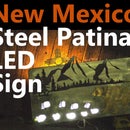Introduction: CNC Plasma Cut Deer Head
In my metalworking shop in Oklahoma City, I build all sorts of things. A year ago a client's son asked me if he could apprentice under me in the afternoons as his High School's "Externship" program.
I've always said there's no value to letting your knowledge die with you, so I accepted and he started training for 6 hours a week with me. As part of that, every few months he has to show off a finished project, and for this project we decided to make a 3D deer head.
If you'd rather watch the video of the build:
And to see how much this kid has grown in just a year, watch his first project, which started on his first day in the shop:
https://www.youtube.com/watch?v=Lhj-27fXeWA
Step 1: Check Files for Fitment
As these plans were developed for laser cutting in 3mm plywood, and we are using 10ga steel which is about 3.2mm. Furthermore, Plasma Cutting is not as precise as laser cutting, so we needed a higher margin of error in our cutting.
Fortunately, in the Plasma Cutting software we can adjust the offset of the cutting tool from the theoretical cut line.
So we cut a test piece and when it didn't fit, we added 2/100 of an inch, which made everything fit perfectly.
Step 2: Correctly Adjusted Plasma Cutting
With our files all sorted out, the rest of our pieces were cut out on the CNC plasma cutting table. A CNC Plasma table is really like a very precise arm, moving the cutting torch around to exactly where we want it, accurate to within 1/100 of an inch. It also looks pretty cool!
Step 3: Grinding
Plasma cutting removes metal by melting it with hot gases and blasting it away. Some of that blasted metal immediately resolidifies on the edges of the cut, leading to a messy, gouda-cheese looking detritus called dross. We remove the dross with a grinder leaving a nice, finished edge that will correctly mate with other pieces.
Step 4: Starting Assembly
All the pieces are intended to slide together with the mating slots. In a laser cut wood piece you could add some glue and call it done. We need to assembly the whole thing then get ready to add some welds.
Step 5: Uh Oh
Unfortunately one of the pieces must have shifted in cutting on the plasma table as each slot had a slight curve to it. We used a grinding disk that is made of high strength steel with diamond particles affixed to it to grind away the curve and fix the piece.
DO NOT ever use a regular cut off disk for this sort of work. They can break and explode. This metal disk is substantially more expensive, but designed for just this use case and is safe!
Step 6: Finish Assembly
My intern slid all the pieces of the deer head together. You can see how easily it all fits once properly prepared.
Step 7: Welding
10ga steel should be welded around 21V and 130Amps in a MIG process. As we are doing small welds called tacks, we opted to increase the voltage a bit, leading to a hotter weld that penetrates the metal more deeply.
Every joint was tacked at least once, in an area it was least likely to be visible.
Step 8: Affixing the Base
The laser cut design did not translate well to the base pieces we cut, so we ground off the slots that should meet up tot he base and welded it into place.
Before welding though, we made some keyholes with a die grinder (like a big dremel). and then offset the deer head up 1/8" with some rods so there would be room for screw heads to sit in the keyhole slots and hold this VERY heavy deer head to a wall.
Step 9: Crooked Antlers
We though the antlers looked a little bland with everything at a 90 degree angle, so we used an Oxy-Acetylene torch to heat the metal up to cherry red. Oxy torches use pure oxygen to make a flame burn as hot as possible to heat things quickly. If we had used a bit more oxygen, instead of softening the metal, it would have melted it away, just like the plasma cutter. After heating the steel, we just added a slight twist in the antlers by hand. WEAR GLOVES!
Also Oxy flames are bright enough to damage your eyes, I am wearing special "shade 5" safety glasses that are analogous to wearing 15 pairs of sunglasses at once.
Step 10: Mounting
Using the keyholes we created a minute ago, we attached two screws to our wall and mounted the deer head in place.
Job Well Done!






